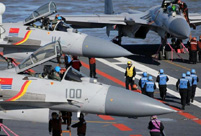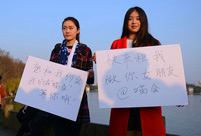

A scene from the latest film of the Kung Fu Panda franchise, which will premiere globally on Jan 29.[Photo provided to China Daily]
Eight years after the first Kung Fu Panda movie made waves globally, Po, the title hero, makes an effort to be less American and more Chinese in the latest sequel of the franchise. Xu Fan reports.
Even foreigners who know little about China see the giant panda as a symbol of the Middle Kingdom. So what often disappoints the Chinese is that most well-known panda character in animation from the Oscar-nominated franchise Kung Fu Panda is completely American. Well, eight years after the first Kung Fu Panda movie made waves globally, the Chinese now have Po, the title hero, making an effort to be less American and more Chinese. In a Chinese version of the film tailored for the world's second-largest movie market, Po and his fellow warriors will speak in Mandarin, though an English version is also available.
The film, Kung Fu Panda 3, premieres globally on Jan 29.
While the previous two films from the franchise were made completely by Hollywood, the latest installment is a Sino-US coproduction backed by Glendale-based DreamWorks and Shanghai-based Oriental DreamWorks and China Film Group.
Explaining the collaboration, DreamWorks' CEO Jeffrey Katzenberg says that the Chinese animators are "a treasure trove" and that the coproduction will promote the Chinese animation industry to the world.
Director Jennifer Yuh Nelson, however, says: "It's always been a big consideration for us to be as authentic as possible in how we treat the culture of China and the history of kung fu movies." The South Korean-American animator, in an e-mail interview with China Daily, says China's movie industry is "promising" and Chinese consumers "are becoming more discerning", which makes a localized version significant when to come to winning over the market.
China's latest annual box-office returns were 44.1 billion yuan ($6.67 billion) from 32,000 screens in around 6,000 cinemas in 2015, up nearly 50 percent year-on-year from 29.6 billion yuan in 2014.
 |
 PLA holds joint air-ground military drill
PLA holds joint air-ground military drill Charming female soldiers on Xisha Islands
Charming female soldiers on Xisha Islands Beautiful skiers wear shorts in snow
Beautiful skiers wear shorts in snow Getting close to the crew on China's aircraft carrier
Getting close to the crew on China's aircraft carrier Chinese stewardess celebrate test flight at Nansha Islands
Chinese stewardess celebrate test flight at Nansha Islands World's first 'underwater skyscraper'
World's first 'underwater skyscraper'  Pentagonal Mart becomes the largest vacant building in Shanghai
Pentagonal Mart becomes the largest vacant building in Shanghai "Rent me as your girlfriend!"
"Rent me as your girlfriend!" A beauty's dancing youth
A beauty's dancing youth Top 20 hottest women in the world in 2014
Top 20 hottest women in the world in 2014 Top 10 hardest languages to learn
Top 10 hardest languages to learn 10 Chinese female stars with most beautiful faces
10 Chinese female stars with most beautiful faces China’s Top 10 Unique Bridges, Highways and Roads
China’s Top 10 Unique Bridges, Highways and Roads Xi arrival shows commitment to Mideast
Xi arrival shows commitment to Mideast Chinese firm aims to build ‘world’s largest cloning factory’
Chinese firm aims to build ‘world’s largest cloning factory’ Qinghai Lake aircraft ban reveals risky trend in wildlife photography
Qinghai Lake aircraft ban reveals risky trend in wildlife photography Foreigners flock to China for cancer, chronic disease treatments
Foreigners flock to China for cancer, chronic disease treatmentsDay|Week